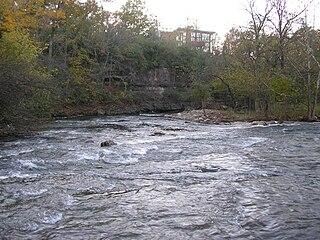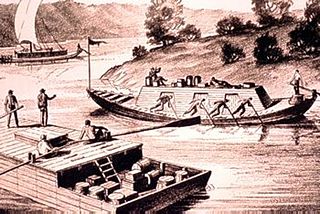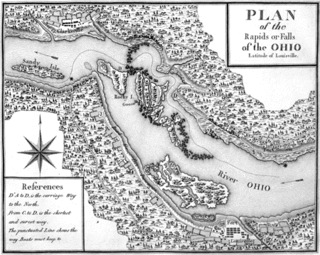
Jefferson County is a county located in the U.S. Commonwealth of Kentucky. As of the 2010 census, the population was 741,096. It is the most populous county in the commonwealth.
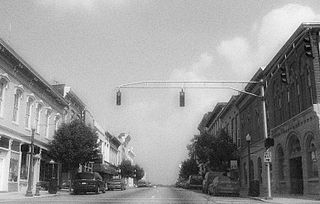
Shelbyville is a home rule-class city in and the county seat of Shelby County, Kentucky, United States. The population was 14,045 at the 2010 census.

The Corps of Discovery was a specially-established unit of the United States Army which formed the nucleus of the Lewis and Clark Expedition that took place between May 1804 and September 1806. The Corps, which was a select group of volunteers, were led jointly by Captain Meriwether Lewis and Second Lieutenant William Clark. Commissioned by President Thomas Jefferson, the Corps' objectives were scientific and commercial even – to study the area's plants, animal life, and geography, and to learn how the Louisiana Purchase could be exploited economically.

Margaret "Peggy" Mackall SmithTaylor was the wife of Zachary Taylor. She was the First Lady of the United States from 1849 to 1850.

USS Louisville (SSN-724), a Los Angeles-class submarine, is the fourth ship of the United States Navy to be named for Louisville, Kentucky. The contract to build her was awarded to the Electric Boat Division of General Dynamics Corporation in Groton, Connecticut, on 11 February 1982 and her keel was laid on 24 September 1984. She was launched on 14 December 1985—sponsored by Mrs. Betty Ann McKee, wife of Admiral Kinnaird McKee, Director of Naval Nuclear Propulsion —and commissioned on 8 November 1986 with Captain Charles E. Ellis in command.

The history of Louisville, Kentucky spans hundreds of years, with thousands of years of human habitation. The area's geography and location on the Ohio River attracted people from the earliest times. The city is located at the Falls of the Ohio River. The rapids created a barrier to river travel, and settlements grew up at this pausing point.
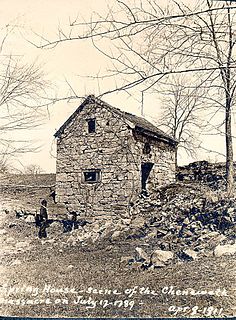
The Chenoweth Massacre of July 17, 1789 was the last major Native American raid in present-day Jefferson County, Kentucky.

Bryan Station was an early fortified settlement in Lexington, Kentucky. It was located on present-day Bryan Station Road, about three miles (5 km) north of New Circle Road, on the southern bank of Elkhorn Creek near Briar Hill Road.
Mary Draper Ingles, also known in records as Mary Inglis or Mary English, was an American pioneer and early settler of western Virginia. In the summer of 1755 she and her two young sons were among several captives taken by Shawnee after the Draper's Meadow Massacre during the French and Indian War. They were taken to Lower Shawneetown at the Ohio and Scioto rivers. Ingles escaped with another woman after two and a half months, making a trek of 500 to 600 miles, crossing numerous rivers and creeks, and over the Appalachian Mountains to return home.
Timeline of Kentucky history

Louisville in the American Civil War was a major stronghold of Union forces, which kept Kentucky firmly in the Union. It was the center of planning, supplies, recruiting and transportation for numerous campaigns, especially in the Western Theater. By the end of the war, Louisville had not been attacked once, although skirmishes and battles, including the battles of Perryville and Corydon, took place nearby.

Squire Maugridge Boone Jr., Squire Boone Jr., or Squire Boone was an American frontiersman, longhunter, soldier, city planner, politician, land locator, judge, politician, gunsmith, miller, and brother of Daniel Boone. In 1780, he founded the first settlement in Shelby County, Kentucky. The tenth of eleven children, Squire Boone was born to Squire Boone Sr. and his wife Sarah (Morgan) Boone in Berks County, Pennsylvania, at the Daniel Boone Homestead. Although overshadowed by his famous brother, Squire Boone was well known in his day.
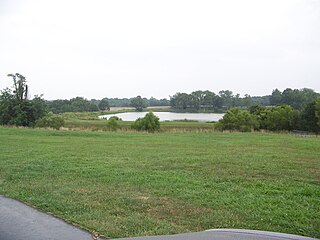
The Long Run massacre occurred on 13 September 1781 at the intersection of Floyd's Fork creek with Long Run Creek, along the Falls Trace, a trail in what is now eastern Jefferson County, Kentucky.
Peter Hackett was born in approximately 1763 or 1764 in the English colony of Virginia. It is believed that Peter was the son of Thomas Hackett, likely of Montgomery County, Virginia. As a boy Peter was bonded out to Captain James Estill, in approximately 1771, and was a part of the broad Scotch-Irish migration along the Wilderness Road through the Cumberland Gap from Virginia into what later became known as Kentucky in the late 18th century. In 1779 he was a resident of Boonesborough, one of the first English-speaking settlements beyond the Appalachian Mountains, and lived there until 1780. Early residents of Boonesborough included Daniel Boone, James Estill, Joseph Proctor, Nicholas Proctor, Adam Caperton, David Lynch, John Colefoot, John Moore, George Robertson, Thomas Miller, Reuben Proctor, Thomas Warren, Peter Hackett, and Thomas Watson. In 1780 Hackett helped establish Estill's Station, Kentucky, and lived there until about 1788.

James John Floyd was an early settler of St. Matthews, Kentucky and helped lay out Louisville. In Kentucky he served as a Colonel of the Kentucky Militia in which he participated in raids with George Rogers Clark and later became one of the first judges of Kentucky.
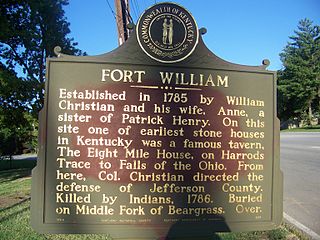
Fort William was a pioneer fort in Kentucky established in 1785 by Colonel William Christian and Anne Christian. William Christian directed the defense of what is now Louisville from attacks by the Indians. The fort was in the area of Jefferson County near St. Matthews and Lyndon. Although the historical marker for Fort William is located in front of the Eight Mile House, an early stone house and tavern, the location of the fort was actually southwest of the Eight Mile House. Fort William was another name for A'Sturgus Station built in 1779 on the Middle fork of Beargrass Creek. After Christian's death in 1786, his wife, Anne, began to refer to the site as Fort William. Anne Christian was a sister of Patrick Henry. The land acquired by the Christians was payment for his service during the Seven Years' War. They moved into the area with children and slaves. After William Christian's death, Anne moved to Mercer County. However, she was ill and traveled to the West Indies in hopes it would improve her health. In 1790, she died either on the return trip from Antigua or the day after arriving in Norfolk, Virginia.

Low Dutch Station was established in 1780 on the middle fork of Beargrass Creek in Kentucky. This station was settled by Dutch pioneers from Pennsylvania and was also known as New Holland Station. The station was one of a group of six forts established on Beargrass Creek during this period in this area that is now a part of Louisville. The leader of the group was Hendrick Banta. The group of settlers were a part of the "Low Dutch Company" and had their own bylaws, a formal charter, and accounting procedures. The group had as its purpose the preservation of the language, culture and religion of the Dutch. The Dutch traveled from a settlement near Harrodsburg to Low Dutch Station.
Floyd's Station was a fort on Beargrass Creek in what is now St. Matthews, Kentucky. In November 1779 James John Floyd built cabins and a stockade near what is now Breckenridge Lane. In 1783, John Floyd, future Governor of Virginia was born in the Station. The pioneer's father was killed by Indians twelve days before the birth of his son. The station was one of six on Beargrass Creek and was involved in local conflict with Native Americans in the area for the next five years. All that remain today of Floyd's Station are a spring house and cemetery.

A station was a defensible residence constructed on the American frontier during the late 18th and early 19th century.

The Kentucky meat shower was an incident occurring for a period of several minutes on March 3, 1876, where what appeared to be flakes of red meat fell from the sky in a 100-by-50-yard area near the settlement of Rankin in Bath County, Kentucky. At the time, Mrs. Crouch, a farmer’s wife, was making soap on her porch one sunny afternoon when she reported seeing the meat pieces fall from the sky. She said she was merely 40 steps from her house when the meat started to slap the ground. The meat looked grisly, according to Mrs. Crouch. Mrs. Crouch and her husband believed the event signified a sign from God. A similar event was later reported, but in Europe. The phenomenon was reported by Scientific American, the New York Times, and several other publications at the time.
